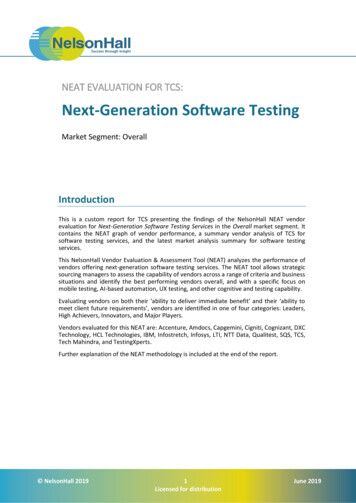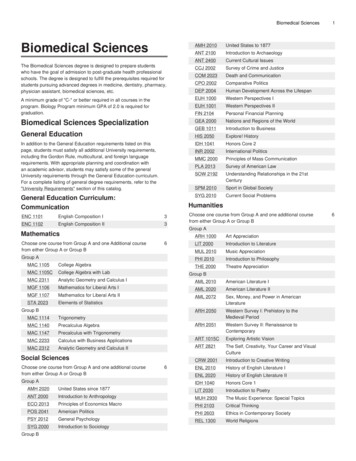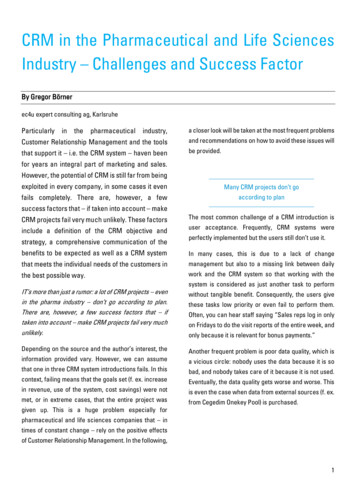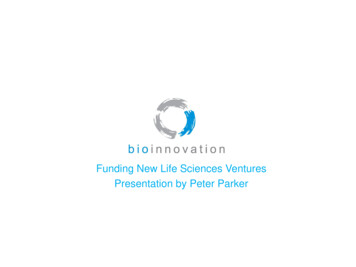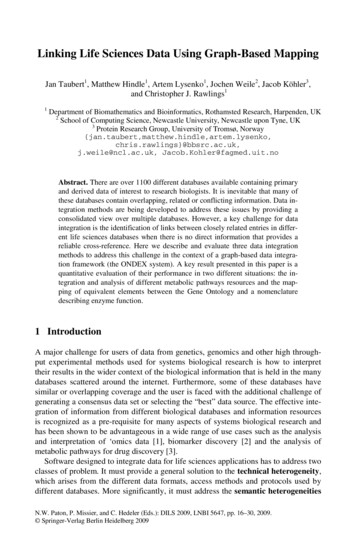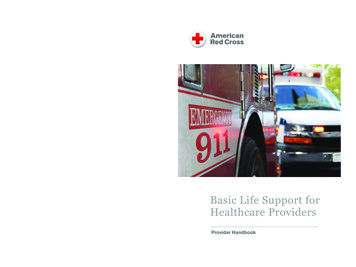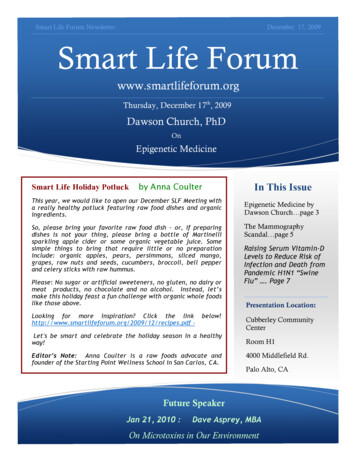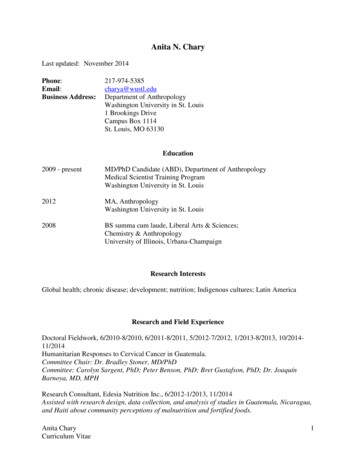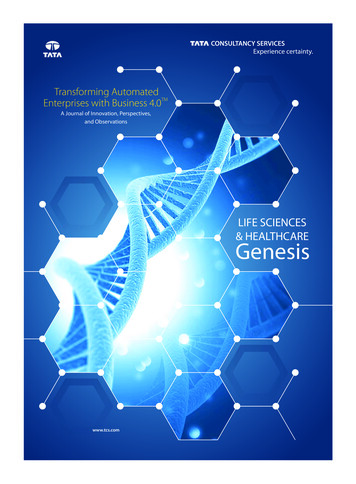
Transcription
Transforming AutomatedEnterprises with Business 4.0TMA Journal of Innovation, Perspectives,and ObservationsLIFE SCIENCES& HEALTHCAREGenesis100957525www.tcs.com50Genesis LS Journal Prepress21 January 2019 17:32:35
FiWhpoDWctsotTdrhRD100957525502TCS Life Sciences I Genesis 2018Genesis LS Journal Prepress21 January 2019 17:32:460
ForewordWelcome to the inaugural edition of Genesis, TCS Life Sciences andHealthcare Thought Leadership Journal.We are living through The Fourth Industrial Revolution that is driving theconfluence of the physical, digital, and biological space. Life sciences andhealthcare organizations are now looking to move from incumbency andoperations to disruption through digital transformation, which requiresthem to harness the power of latest technologies to meet the challenges ofMr. Debashis Ghosh evolving business models. Business 4.0 TM, TCS’ thought leadershipPresident - Life Sciencesframework, helps enterprises transform to be digital and Industry 4.0and Healthcare Unit, TCSchampions leveraging technological platforms that have been built tobe intelligent, agile, on the cloud, and automated.When I interact with industry leaders, I observe that their focus areas are patient centricity, affordablehealthcare, personalized medicine, artificial intelligence for accelerated drug discovery, predictive &prescriptive analytics for intelligent clinical trials, and so on. Practitioners are looking to exploreopportunities with newer technologies such as blockchain, AR/VR, machine learning, supply chain andDNA sequencing to drive their growth agenda.With continuous investments in future-ready solutions, genomics research, domain expertise, and digitalcapabilities, we are laying a foundation for the future growth of our customers. Sharing the same foresight- an endeavor to improve human life, we are collaborating with our customers and partners to adopt newtechnologies and embrace the risk of venturing into an unchartered territory to create value for allstakeholders. With these thoughts, we have put forth our perspective in this edition of Genesis, discussingour Business 4.0TM vision, cutting-edge life sciences innovations, and emerging technologies that aretransforming the industry and shaping the future.The edition explores how organizations can leverage automation to create exponential value, improvedrug efficacy and safety, increase returns from their R&D costs, and meet the demands of a complexregulatory landscape – to be able to focus more on what matters the most – improving patient lives. Wehope you find this issue insightful.Regards,Debashis Ghosh1009575255TCS Life Sciences I Genesis 2019Genesis LS Journal Prepress21 January 2019 17:32:58030
CONTENTSIN CONVERSATION WITH26FOCAL POINTSmart Automationto Steer Agility andTransformationin the Life Sciences Industry06A Defense againstthe Old Arts: AutomatingLife Sciences & Healthcare12TMin a Business 4.0WorldScaling beyondhuman capabilities –need for AI basedautomation in LifeSciences1822AutAutomatingClinicalTrial Data Management:tmA business 4.0RoadmapAutomation: Taking CareDelivery Forwardin the Healthcare Industry10095752550Genesis LS Journal Prepress21 January 2019 17:33:06
34SPOTLIGHT30THAchieving OperationalCoherence: Unifyinga PharmaceuticalMajor’s GlobalR&D Operations38Matters of theHeart - PhysionetCase StudyListen and Learn AutomatingPharmacovigilanceMonitoring withTCS IPS DecisionFabricTMstry42TCS StreamlineseTMF ImplementationProcess by Reducing70% ManualIntervention10095752550Genesis LS Journal Prepress21 January 2019 17:33:11
thauA Defense against the Old Arts:Automating Life Sciences &TMHealthcare in a Business 4.0 WorldThe life sciences and healthcare industry is under tremendous pressure to continuously evolve andremain relevant in what is already a volatile market. Regulatory scrutiny is at an all-time high. Industrywide incompatibility, combined with the absence of a robust international compliance structure, hasadverse effects on bringing in hitherto unexplored manufacturing strategies and business models. Suchscrutiny coupled with the attention of global tax structures affects pro tability in the sector as well. Onother hand, healthcare providers are struggling to use technology to lower costs and provide valuebeyond medical devices. Pharmaceutical companies are facing slow product approvals, increasing payerdemands for product performance, and mounting pricing pressure.nnnnnnnn100957525506TCS Life Sciences I Genesis 2019Genesis LS Journal Prepress21 January 2019 17:33:180
dFOCAL POINTIn order to stay relevant and competitive, life sciencesThe IT ecosystem in the industry needs a change thatand healthcare companies need to reengineer theirfacilitates the development and deployment of smartercurrent business models to be more proactive,platforms, which can both enable digital transformationpreventive, participative, and personalized. In thisin life Sciences and healthcare ecosystem as well asregard, RPA and advanced automation techniquescomply with rigid privacy and other regulations. For this,(intelligent automation – including robotic processfirms need to collate data from a wide variety of sources,automation, natural language processing, artificialsuch as wearables and healthcare systems, to provideintelligence, machine learning, and computer vision)regulators with greater visibility. Companies need tohold immense potential.wholly embrace a transformationalapproach to bring paradigm shift inR&D is becoming lesst h e w ay t h e e n te r p r i s e s a reproductive making it a constantmanaged. This can be enabled byendeavor of companies to lookBusiness 4.0TM thought leadershipfor new innovative models,framework, which is centered ontechnologies, and processes tomaking an enterprise agile andaddress this. This is leading to anintelligent by adopting emerging‘innovation deficit’ that hastechnologies such as AI, digital andmassive ramifications for themost pertinently, automation.There is a fundamental shift in howindustry as a whole.l i fe s c i e n c e s a n d h e a l t h c a r ecompanies are managing andsupporting their business processes. The outcome isgenerally an intelligent automation roadmap outliningshort-term, mid-term, and long-term views and how toimplement the roadmap using agile delivery methodsallowing companies to adapt.To fulfil this ultimate aim, automation can hold manymeanings. It can mean making the most out of theAs a short-term opportunity, the companies arecurrent system at hand, it can also mean replacing theleveragingRPA solutions for achieving efficiency andcurrent system with a wholly new structure thatproductivitygain. They have started to realize the benefitexpedites all ongoing processes. The core objectiveRPAcanprovideand how such solutions can free up theremains the same.budget for investment in transformational changesusing advanced automationThere are some key technologiestechniques – artificial intelligence,that function as enablers forThe creation andm a c h i n e l e a r n i n g, c o g n i t i veautomation:application of technology tocomputing, and computer vision.monitor and control product andn Deep Learningservice production and deliveryn Artificial Neural Networksis what we know to ben Cognitive Computingautomation. While there aren Speech/Image Processingwide-ranging objectives ofn Robotic Process Automationautomation, the most importantn Natural Language Processingone is to deliver a qualityn Conversational Agentsapplication at speed.n Machine LearningReshaping LifeSciences andHealthcareAutomation: TheGame Changerdshner1009575255TCS Life Sciences I Genesis 2019Genesis LS Journal Prepress21 January 2019 17:33:26070
Automation DriversBusiness BenefitsReal-world ExamplesSmarter & IntelligentProcessingRaise throughput, Improveoutcomes, Improve accuracy,Reduce human errors, Eliminatehuman biasesTransforming unstructured text tostructured text, virtual assistance,automated documents, notes orfeedback classi cationSimpli cation &Re-imaginationSimplify business processes,Expand the discovery of newsolutionsPersonalizing treatment/medicine,Target and compoundidenti cation, KnowledgemanagementSolve complex problems,Signi cantly impact decisionmaking, Multiply productivity,Drive patient-centricity, Enhancebrand reputationIdentifying potential diseasetreatments, Reducing cost byoptimizing manufacturingprocesses, Speeding up drugdiscoveryCompetitiveAdvantage e 1: Key Intelligent Automation DriversIntelligent Automation: Going Towards the Big ShiftAutomation technologies have evolved from isolated end-user process automation to enterprise-wideinstallation and now to advanced automation techniques. Over the last few years, this has allowedcompanies to adopt end-user process automation across organizations leading to all-pervading doubledigit productivity improvements. As the technology is evolving further by acquiring more humanintelligence and the ability to mimic human actions, companies are gradually moving from RPA tomachine learning to cognitive capabilities thereby gearing up for the big shift in the way they work. Fewcompanies have even started to setup a separate unit to manage their intelligent automation enabledbusiness process transformation.The AI-based Capabilities SpectrumAnticipates HumanActionsMimics HumanActionAugments HumanIntelligenceMimics HumanJudgementRobotic ProcessAutomation andImage ProcessingSmart ProcessAutomationMimics tVirtualAgentsCognitiveTechnologiesFigure 1: AI-based Capabilities Spectrum100957525508TCS Life Sciences I Genesis 2019Genesis LS Journal Prepress21 January 2019 17:33:330
Implementing Positive Results in ProcessesThe life sciences and healthcare industry looks to reducing operational costs and improving efficiency of currentprocesses. In an intelligent, agile, and automated world running increasingly on the cloud, intelligent automationplays a vital role in fulfilling boththese purposes. The areas in whichIt has been observed that mostthis can be most effective are claimsprocessing, customer onboarding,payers have crossed 85% in autoand care management.adjudication and for theDuring the customer onboardingprocess, it has been typical to see theremaining 15%, there are plentyimplementation of quite a fewcharacter recognition tools, whichof opportunities for intelligentcould interpret handwriting, convertit digitally, and correct errors in thedecision-making. Somecaptured data more intelligently.examples include handlingThe table below shows how suchhealthcare requirements and selectsacross the value chain that can drivelife sciences:ednowdnewborn and other out-layersthat need manual attention,mapping checks for settlements,and checking payments thatallowfraud detection duringclaims processing.Business ProcessesSelected Use CasesBusiness Benefitsü ICR & RPA increases the accuracy and 80% increase inproductivityICR & RPA for paperprocessingClaimsProcessingintelligent automation transformsintelligent automation use casesmore result-oriented innovation inü Scrubber is built to validate the data against the membershipAPI's and which will auto resolve the errorsFraud Deductionü AI & ML deducts frauds easily and improves saving by 8%MDM, Data Duplicatesand Linkagesü 7% increase in productivityEligibility ExceptionsEnrollmentProcessingpaper processingMedicalCodingIntelligentDecision Makingü Platform overlays are captured and handled via RPAü New born and other exception scenarios and handled via RPA andintelligent decision making which increases the productivity by 8%ü 35% increase in productivityICR & RPA forü 30% reduction in turnaround timeü 50% increase in the productivityü Medical coding is executed in near real time after patient visitü Reduces Compliance RiskPrescriptionsDuplicate Order Resolutionon Prescriptions100ü Manual effort in analyzing and fixing is fully removed95ü Increase in productivity75ü Improved Quality and customer experienceFigure 2: Select Automation Opportunities in Healthcare255TCS Life Sciences I Genesis 2019Genesis LS Journal Prepress21 January 2019 17:33:36090
Business ProcessesSelected Use CasesImage analysis inKaryotypingReconciliation of lab dataü Faster data intensive hypothesis driven drug discoveryKnowledge platform fordiscovery researchü Reduces R&D costü Increases accuracyü Enhances complianceü Reduces risk of operationsRegulatory IntelligenceModular AuthoringQuality checkEnd-to-end regulatoryaffairs activity workflowPrAIdeLab Analyte Extractionin CDMAutomated NarrativeWritingState Board SanctionsApauClinicalDevelopmentAutomated RedactionInseopWü Increases productivityü Enhances regulatory complianceAsvarugithinpoalg(Ethcaü Reduces manual errorü 75% improved productivity for case assignmentü 90% accuracy of causality assessment solutionü Reduces dependency on physiciansCompilation of tradedocumentsOrder entry and allocationInvoices status updateAutonomousdocumentationAutonomous freight entryImage analysis to determinesafety risksLecoü Reduces turnaround timeü Increases compliances, reduces riskEnhances accuracyManufacturing& Supply ChainThanmü Improves success rateü Increases productivityRegulatoryAffairsTü Reduces drug discovery time frameRepurposing of DrugLab/ResearchBusiness BenefitsEnd-to-end CaseAutomationCase narrativegenerationPharmacovigilanceQuality reviewCausality assessmentü Timely compilation & distribution of documentsü Personnel productivity improvement by 20-50%ü Reduce time spent due to manual errorü Increase compliance and reduces risk ofoperationsü Reduces customer center queriesby 40%KOLs identification andassessmentü Saves medical reps time by 20-30%Email personalizationü Real-time query resolutionSales notes feedbackand request analysisü Reduces dependency on manual and memorybased knowledge managementSales ProspectsClassificationSales &Market
21.01.2019 · Healthcare There is a fundamental shift in how life sciences and healthcare companies are managing and supporting their business processes. The outcome is generally an intelligent automation roadmap outlining short-term, mid-term, and long-term views and how to implement the roadmap using agile delivery methods allowing companies to adapt.
